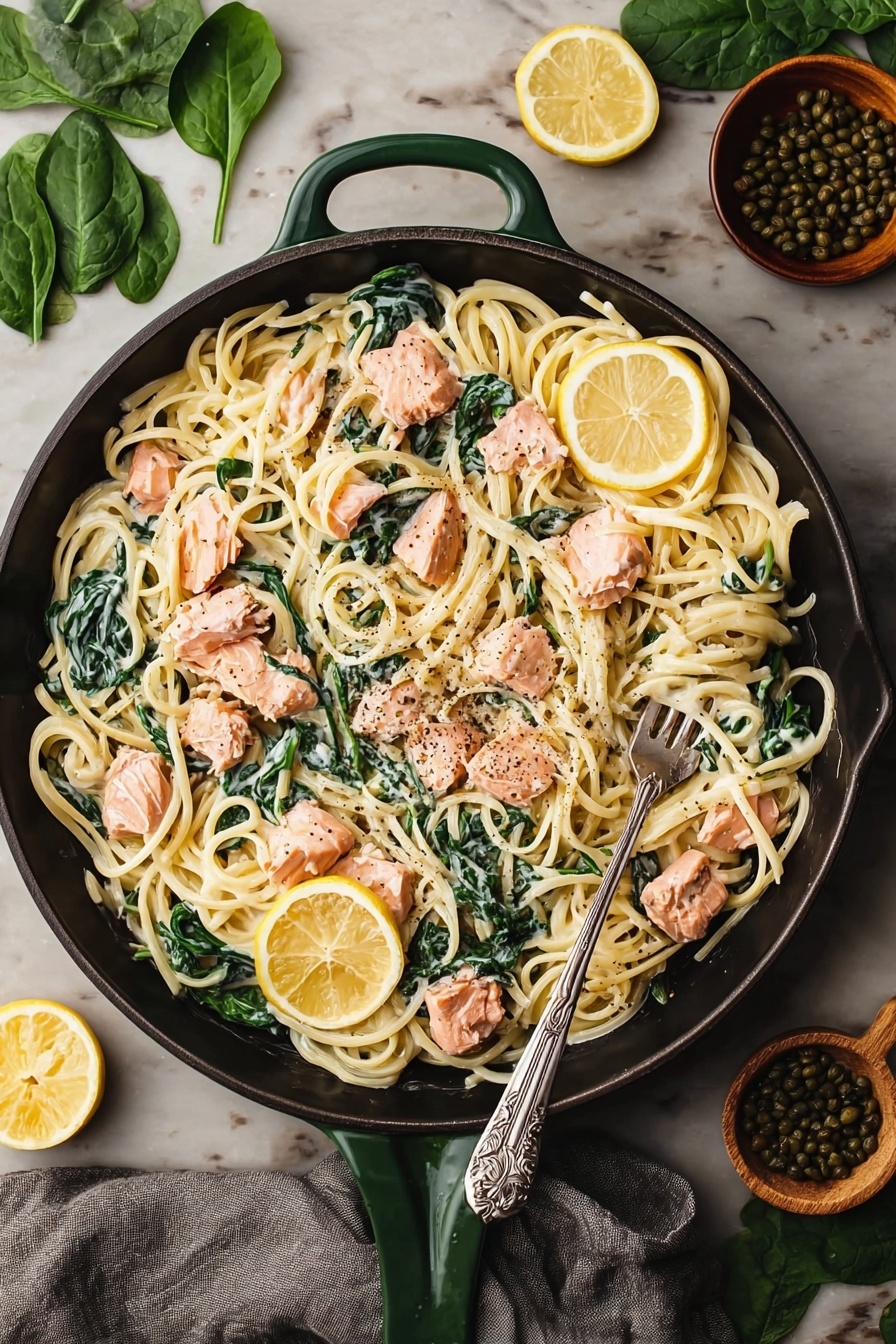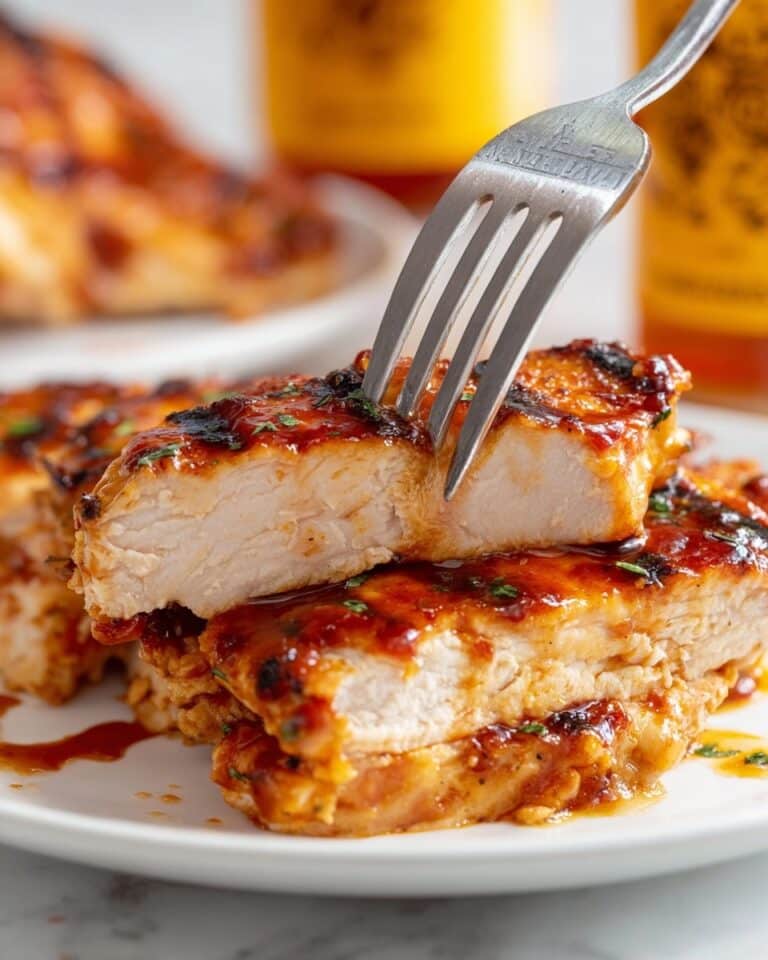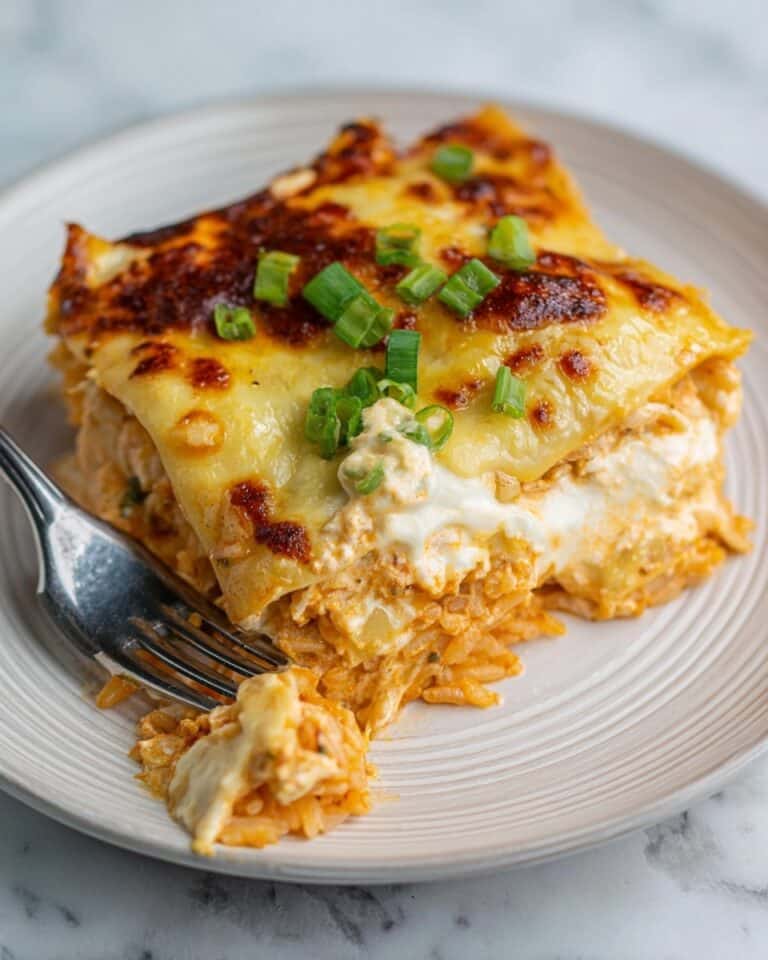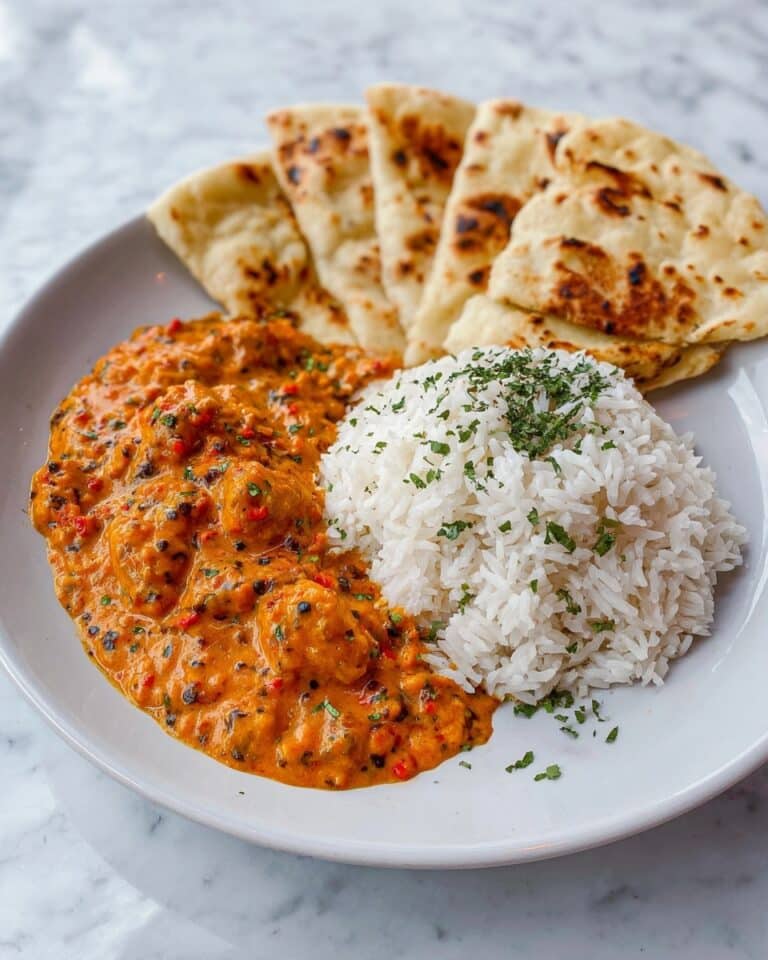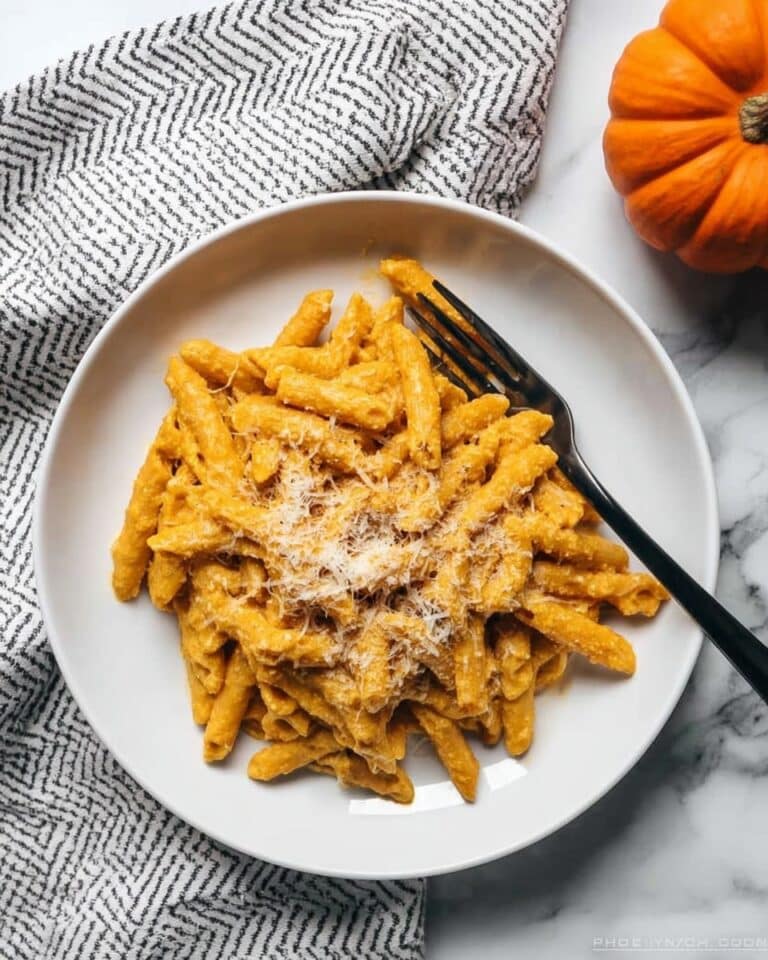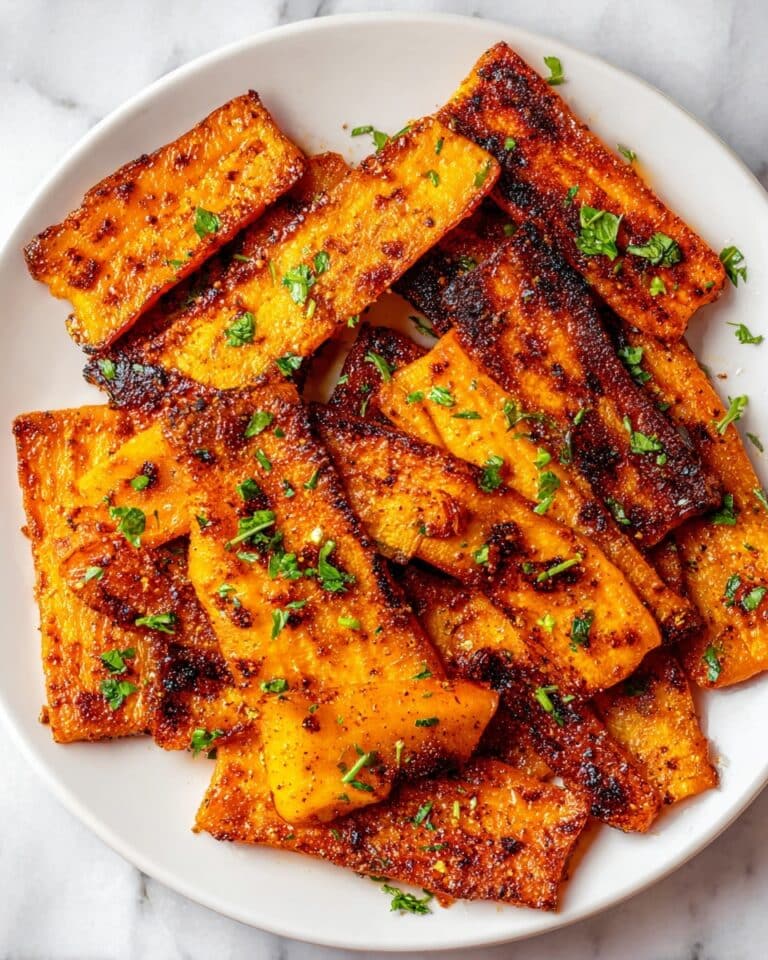Creamy Salmon Pasta Recipe
If you’re craving a dish that’s both luxurious and comforting, allow me to introduce you to my favorite **Creamy Salmon Pasta Recipe**. This one’s a total game-changer! Imagine flaky, oven-baked salmon mingling with a silky, garlicky cream sauce, tender linguine, and bright pops of lemon and capers. Trust me, once you try it, you’ll want to make it again and again. I can’t wait to walk you through my step-by-step approach so you can nail this at home without any stress.
Why This Recipe Works
- Perfectly flaky salmon: Baking the salmon gently keeps it moist and tender without the fuss of pan-searing.
- Creamy, flavorful sauce: A simple combo of butter, garlic, cream, and white wine creates a luscious sauce that clings to every strand of pasta.
- Bright, fresh accents: Lemon zest, capers, and baby spinach add vibrancy and balance out the richness beautifully.
- Hands-off pasta prep: Cooking the pasta al dente and combining it directly in the sauce ensures maximum flavor absorption with minimal cleanup.
Ingredients & Why They Work
These ingredients come together like old friends. Each one plays its part, from the richness of the cream to the brightness of the capers and lemon zest. I recommend using fresh salmon fillets and a good dry white wine–it really lifts the sauce. And if you grab baby spinach already washed, you’ll be saving time, which I always appreciate!
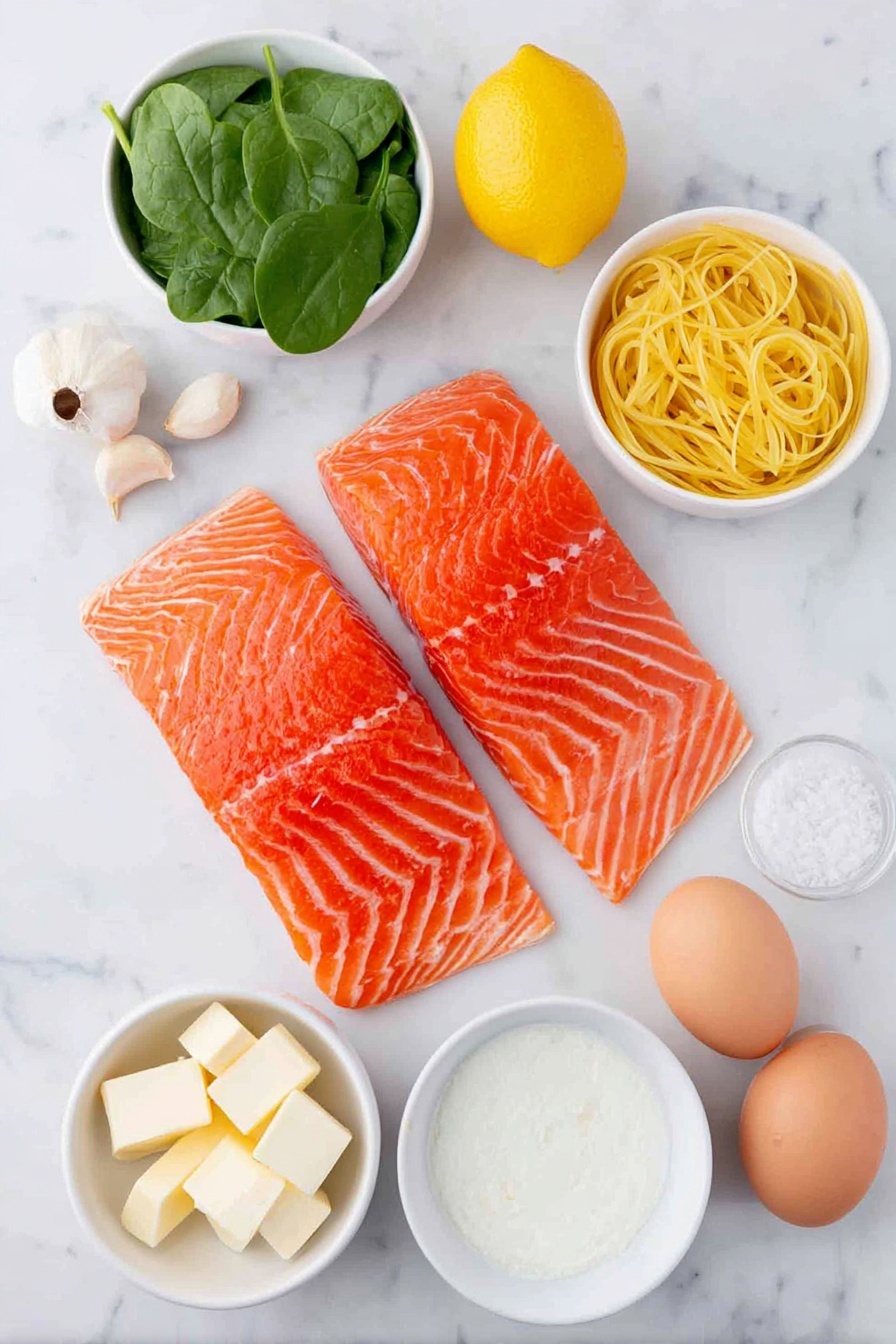
- Salmon fillets: Choose fresh or thawed wild or farmed salmon with skin—it helps keep the flesh intact during baking.
- Kosher salt: I like kosher salt because it dissolves evenly and seasons better.
- Black pepper: Freshly ground is best for a bit of bright heat without overpowering.
- Linguine: This long pasta holds the sauce beautifully, but feel free to swap with fettuccine or even spaghetti.
- Unsalted butter: Use unsalted so you can control the seasoning perfectly.
- Garlic cloves: Fresh minced garlic adds that unmistakable punch everyone loves.
- Heavy cream: The backbone for that creamy, dreamy sauce–full-fat is key!
- Dry white wine: Adds subtle acidity and depth; a Sauvignon Blanc or Pinot Grigio works well.
- Grated lemon zest: Fresh zest packs a citrus punch without the extra liquid.
- Baby spinach: Adds freshness and softness, plus those pretty flecks of green.
- Capers: Tiny bursts of salty brine that cut through the richness perfectly.
- Lemon wedges (optional): For an extra squeeze of brightness right before eating.
Tweak to Your Taste
I absolutely love personalizing this creamy salmon pasta recipe to suit whatever’s in my fridge or my mood that day. Don’t be shy about making it yours—you can easily swap ingredients or play with the flavors.
- Variation: I sometimes toss in cherry tomatoes for a pop of sweetness and color—it brightens things right up!
- Dietary swap: Use coconut cream instead of heavy cream and gluten-free pasta for a dairy-free, gluten-free version that tastes just as indulgent.
- Herbs: Fresh dill or parsley stirred in just before serving gives a wonderful aromatic lift.
- Heat it up: If you like a little kick, a pinch of red pepper flakes mixed into the sauce is fabulous.
Step-by-Step: How I Make Creamy Salmon Pasta Recipe
Step 1: Baking the Salmon to Perfection
Start by preheating your oven to 350°F and preparing a rimmed baking pan with nonstick spray. I like to sprinkle the salmon fillets with half the salt and pepper before baking them skin-side down. This gentle bake takes roughly 14–16 minutes, just until the salmon is almost opaque and flakes easily. Using a meat thermometer, you’re aiming for an internal temp of 145°F. Leaving it slightly undercooked is better than drying it out—remember it’ll cook a bit more when combined with the sauce later.
Step 2: Cooking Linguine Just Right
While your salmon is baking, bring a large pot of salted water to a rolling boil and cook the linguine according to package instructions until al dente. A large pinch of salt in the pasta water is key—it seasons the pasta from within. Drain it promptly to avoid mushiness, but save a splash of pasta water if you like a looser sauce.
Step 3: Crafting the Creamy Garlic Sauce
Now, melt butter in a large, high-sided skillet over medium heat and add a good handful of minced garlic. Stir constantly for about a minute until fragrant—don’t let it brown or it will turn bitter. Pour in the heavy cream, white wine, lemon zest, plus the remaining salt and pepper. Turn up the heat just until it boils, then immediately lower to medium and let it thicken for 5 to 6 minutes, stirring frequently. You want a sauce that coats the back of a spoon but isn’t pudding-thick. When it gets there, turn the heat to low and you’re ready for the next step.
Step 4: Adding Spinach, Capers & Pasta
Stir in fresh baby spinach and capers—the spinach will wilt down quickly, giving you those pretty vibrant greens. Then add your drained linguine right on top. Toss everything gently but thoroughly over low heat for 1–2 minutes until the spinach is just wilted and the pasta soaks up some of that silky sauce. This finish keeps the sauce lush and creamy.
Step 5: Flaking Salmon & Serving
Remove the salmon from the oven and using a spatula, gently slip it between the skin and flesh to discard the skin. Break the salmon into large, rustic chunks and fold it gently into the pasta. Serve with lemon wedges on the side—you’ll love how a little squeeze just before diving in brightens every bite.
Pro Tips for Making Creamy Salmon Pasta Recipe
- Don’t skip seasoning the pasta water: It really makes a difference to the final flavor, so add a generous pinch of salt.
- Keep the cream sauce gently simmering: Too high heat can break the sauce, so watch your temperature closely.
- Be gentle folding in the salmon: You want big flaky pieces, not mushy bits, so fold carefully with a spatula.
- Use fresh lemon zest, not bottled: The fresh zest gives a bright flavor and lovely aroma you just can’t beat.
How to Serve Creamy Salmon Pasta Recipe
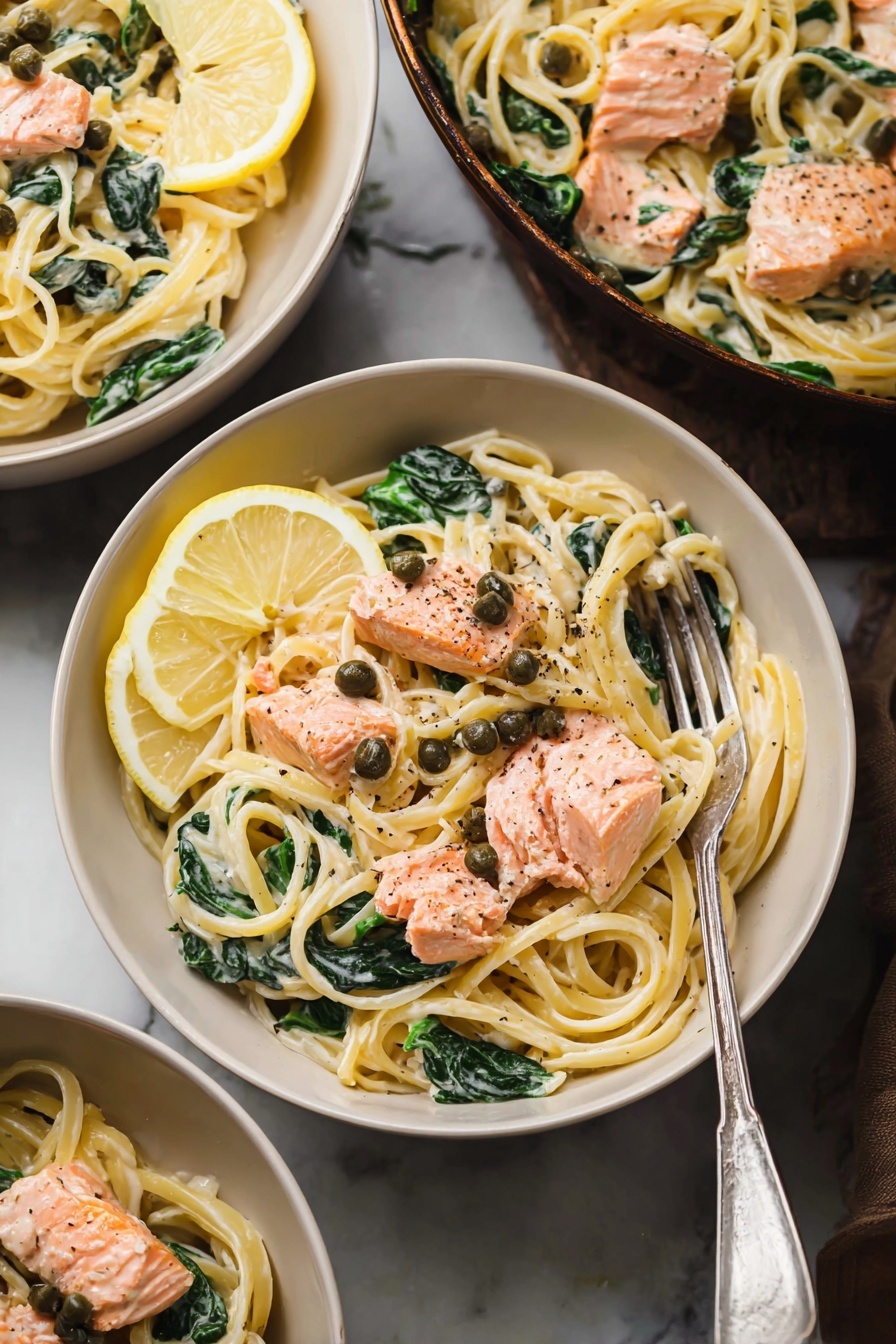
Garnishes
I always toss a few fresh lemon wedges on the side because a squeeze right before eating adds that zesty brightness that cuts through the richness perfectly. If I have it on hand, a sprinkle of chopped fresh parsley or dill on top makes it look restaurant-worthy and adds freshness.
Side Dishes
Since this dish is pretty rich, I like to keep sides light and simple—think a crisp green salad with a lemon vinaigrette or some roasted asparagus with a drizzle of olive oil and a pinch of sea salt. Garlic bread works too if you want something cozy and indulgent.
Creative Ways to Present
For special occasions, I’ve plated this with the salmon chunks artfully arranged on top of twirled nests of pasta and garnished with edible flowers or microgreens. It’s a showstopper that looks way fancier than it is—and people always ask for the recipe!
Make Ahead and Storage
Storing Leftovers
Leftover creamy salmon pasta stores well in an airtight container in the fridge for up to 3 days. I find it actually tastes even better the next day as the flavors meld, but the spinach will be softer, so keep that in mind.
Freezing
I’ve frozen this pasta a couple of times—just portion it out before adding fragile spinach. Freeze in freezer-safe containers and thaw overnight in the fridge. The texture remains pretty good, though the spinach softens quite a bit after thawing.
Reheating
To reheat, gently warm the leftovers over low heat in a skillet, adding a splash of cream or milk if the sauce needs loosening. Stir frequently to avoid sticking and keep that luscious creamy texture. Microwave can work in a pinch, but I recommend the stove method for best results.
FAQs
-
Can I use frozen salmon for this creamy salmon pasta recipe?
Absolutely! Just make sure the frozen salmon is fully thawed and patted dry before baking to ensure it cooks evenly and doesn’t get watery. Adjust baking time slightly if the fillet is thicker.
-
What’s a good substitute if I don’t have white wine?
You can substitute the white wine with extra broth (chicken or vegetable) plus a squeeze of lemon juice for acidity. It won’t have the exact same depth but still keeps the sauce vibrant and flavorful.
-
Can I make this dish dairy-free?
Yes! Swap out the heavy cream with full-fat coconut milk or a creamy dairy-free alternative. Make sure your butter is also dairy-free or substitute with olive oil. The flavor will be different but still delicious.
-
How do I prevent the cream sauce from breaking?
Keep the sauce at a gentle simmer and avoid boiling it vigorously. Stir often and reduce heat as soon as it thickens. Adding the cream later in the process helps maintain smoothness too.
-
Can I use a different pasta shape?
Definitely! Linguine is traditional here, but fettuccine, tagliatelle, or even penne works well with a creamy sauce. Just adjust cooking time accordingly.
Final Thoughts
This Creamy Salmon Pasta Recipe has been one of my go-to “fancy but easy” dinners whenever I want to impress without the stress. It’s comfort food with a touch of elegance, and I hope it becomes one of your favorites too. Trust me, once you master it, you’ll be making it for friends, family, or even a cozy night in with yourself. So grab your salmon, fire up the stove, and get ready for some seriously delicious pasta magic!
Print
Creamy Salmon Pasta Recipe
- Prep Time: 15 minutes
- Cook Time: 25 minutes
- Total Time: 40 minutes
- Yield: 4 servings
- Category: Main Course
- Method: Baking
- Cuisine: American
- Diet: Low Lactose
Description
This creamy salmon pasta recipe combines tender baked salmon with a luscious garlic cream sauce, brightened with lemon zest and fresh spinach. Perfect for a comforting yet elegant dinner, it features linguine tossed in a rich sauce with capers for a subtle tang and finished with fresh lemon wedges.
Ingredients
Main Ingredients
- Nonstick cooking spray
- 2 salmon fillets about 3/4 pound (1 large fillet is also fine)
- 1 teaspoon kosher salt divided, plus more for pasta water
- 1/2 teaspoon ground black pepper divided
- 12 ounces linguine
- 2 tablespoons unsalted butter
- 3 garlic cloves minced
- 1 1/4 cups heavy cream
- 1/2 cup dry white wine
- 1 teaspoon grated lemon zest
- 1 box baby spinach 5 ounces
- 2 tablespoons capers
- Lemon wedges for garnish (optional)
Instructions
- Preheat and Bake Salmon: Preheat your oven to 350 degrees F and bring a large pot of water to a boil on the stove. Spray a small rimmed baking pan with nonstick cooking spray. Place the salmon fillets skin-side down on the pan, then sprinkle with 1/2 teaspoon kosher salt and 1/4 teaspoon ground black pepper. Bake the salmon for 14 to 16 minutes until it is almost opaque and reaches an internal temperature of 145 degrees F.
- Cook Linguine: While the salmon is baking, add a large pinch of salt to the boiling water and cook the linguine according to package directions until al dente.
- Prepare Cream Sauce: In a large high-sided skillet, melt the unsalted butter over medium heat. Add the minced garlic and sauté for 1 minute, stirring constantly to avoid burning. Pour in the heavy cream and dry white wine, then add the grated lemon zest along with the remaining 1/2 teaspoon salt and 1/4 teaspoon pepper. Bring the mixture to a boil over medium-high heat, then reduce heat to medium and simmer for 5 to 6 minutes, stirring frequently, until the sauce thickens slightly to a thin sauce consistency. Lower the heat to keep warm.
- Add Spinach and Capers: Stir the baby spinach and capers into the sauce, allowing the spinach to wilt slightly as you prepare the pasta.
- Toss Pasta and Wilt Spinach: Drain the cooked linguine and add it directly to the skillet over the spinach and sauce. Toss over low heat for 1 to 2 minutes, stirring frequently, until the spinach is just wilted and the pasta is fully coated with the sauce.
- Assemble and Serve: Remove the salmon from the oven. Use a spatula to carefully separate the salmon flesh from the skin; discard the skin. Break the salmon into large chunks over the prepared pasta. Serve immediately garnished with lemon wedges to squeeze over the dish if desired.
Notes
- Use a food thermometer to ensure salmon reaches a safe internal temperature of 145 degrees F.
- Substitute baby kale or arugula for spinach if preferred.
- Dry white wine can be replaced with chicken broth for a non-alcoholic version.
- To make this dish lighter, use half-and-half instead of heavy cream, but the sauce will be less rich.
- Reserve some pasta water to thin the sauce if it becomes too thick while cooking.
Nutrition
- Serving Size: 1 serving
- Calories: 650 kcal
- Sugar: 3 g
- Sodium: 600 mg
- Fat: 40 g
- Saturated Fat: 20 g
- Unsaturated Fat: 15 g
- Trans Fat: 0 g
- Carbohydrates: 45 g
- Fiber: 4 g
- Protein: 35 g
- Cholesterol: 140 mg

